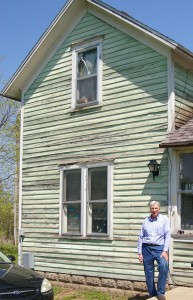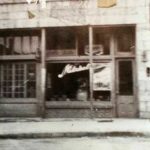“They began moving day in the rolling hills of Southwest Wisconsin, crossed the Military Ridge, and then slowly descended crests and valleys toward their new home on the Wisconsin River… At dusk a breeze swept down from the bluffs and cleared the fog away, and then he saw it: a plain, double story house with double-hung windows. They rode another ten minutes and turned onto a long, snow covered drive.” — Bittersweet Harvest
Harold’s Favorite Places: The Farm at ‘Willow’
As my second novel Bittersweet Harvest begins, Will and Mary O’Shaughnessy and their three daughters have reached their new farm at Willow, Wisconsin, along the Wisconsin River. Will O’Shaughnessy has convinced his family to leave behind their home in Ashley Springs, Wisconsin, and his Ford Dealership there, to return to farming. The move has taken an entire day, through the snow. Their belongings follow on packed sleds.
In the O’Shaughnessy Chronicles novels, Willow and Ashley Springs are fictionalized names of real places in Iowa County, Wisconsin. Willow, in real life, is the village of Avoca on State Hwy. 133 in northern Iowa County, near the Sauk County line. Ashley Springs, in real life, is the city of Mineral Point in southern Iowa County.
The two, real-life communities are separated by about 50 miles of winding hills and soaring bluffs. About three miles east of the village of Avoca there still exists the remains of a farm that is very special to me, and to my family. It is the farm in Bittersweet Harvest.
My grandparents, Will and Elizabeth Fitzsimons, moved their family from Mineral Point to this farm around 1918, when my mother, Laura Annette Fitzsimons, was in the seventh grade.
Places aren’t the only real-life elements in my novels.
When I sat down to write the O’Shaughnessy Chronicles, I drew much of my material from my mother’s 1999 memoir, From High on the Bluff. I strove in my novels to remain as true to her real-life story as possible, while fictionally filling in gaps and allowing myself some creative freedom.
In the O’Shaughnessy Chronicles, the fictional characters of Will and Mary O’Shaughnessy are based on my grandparents. Will and Mary’s three daughters – Catherine, Sharon, and Ruby – are based on my mother and her two sisters, Annie and Alice. My mother also had a third sister and a brother that I did not include in my novels.

At the Avoca farm in the 1920s. Pictured clockwise from top left are my Aunt Alice, my mother, my grandparents, Will and Elizabeth Fitzsimons, and their dog, Teddy.
Here’s how my mother, in From High on the Bluff, recalls her family’s arrival at Avoca.
“We didn’t know a soul around Avoca and had never lived on a farm before, so it was kind of scary for me and Alice. But there were horses, cows, pigs, chickens, cats, and a wonderful dog, Teddy.”
I made sure to include Teddy in the O’Shaughnessy Chronicles. In Bittersweet Harvest, the O’Shaughnessy family inherits a black-and-white English sheepdog, named Teddy, from the previous owner of the farm at Willow.
Today, Avoca remains a tiny community with a population of about 650 residents.

Me and my cousin, Wayne
The farm still exists. I was thrilled on a recent visit with my cousin, Wayne, to find the barn, house, and many of the outbuildings still standing, and to find it still an operating farm. The bluffs that rise sharply across Hwy. 133 are as my mother described them in her memoir. I appreciate the graciousness, on the day of our unannounced visit, of Beth Zadrazil. She allowed us to wander and to take photographs. Beth’s husband’s family has owned the farm now for several generations.
An active Wisconsin & Southern Railroad line still crosses the long driveway. The rail line is mentioned both in my novels and in my mother’s memoir.
So, too, are rattlesnakes mentioned in both my novels and in my mother’s memoir. Rattlesnakes can still be found on the bluffs, Beth Zadrazil confirmed.
“It was said that rattlesnakes never cross the railroad tracks. Our barns were very close to the tracks, and we never saw one on that side of the tracks or in the yard around the house,” my mother wrote.
My grandparents only lived on the Avoca farm for about seven years.
My grandfather was a progressive farmer. He experimented with newfangled crops like alfalfa and soybeans before they became popular. In part, I believe, because of trying new things that the market wasn’t quite ready for, he was hit hard by an economic downturn in the mid-1920s. This was a downturn that particularly hit farmers a half-decade before the stock market crash of 1929 officially ushered in the Great Depression. Around 1925, my grandparents lost the farm at Avoca to bankruptcy, and moved to Ridgeway, Wisconsin. This wasn’t long after my mother graduated from Avoca High School in 1924. A few years later, they moved back to Mineral Point.
I fictionalize this difficult stretch of my grandfather’s life near the end of Bittersweet Harvest, as Will loses the farm at Willow and moves to Logan Junction. In Bittersweet Harvest, Logan Junction is a fictional name for Ridgeway, Wisconsin.
“All that he’d hoped for, all that he’d worked for, was over. He couldn’t make the payments, so the bank called his loan.”
Sadly, bankruptcy and emotionally-wrenching auctions are part of the real-life story of many 20th Century farm families, not just my mother’s.
Photo Gallery
Check out additional photos of the farm. All images ©2014 Inkspots, Inc.
- The long driveway, and high bluffs.
- An old farm wagon
- With Beth Zadrazil, our gracious hostess
- An outbuilding
- Me by the barn
















